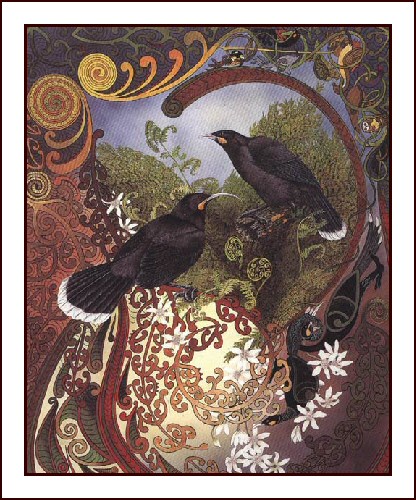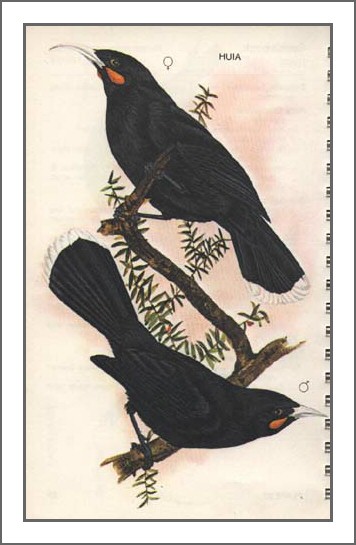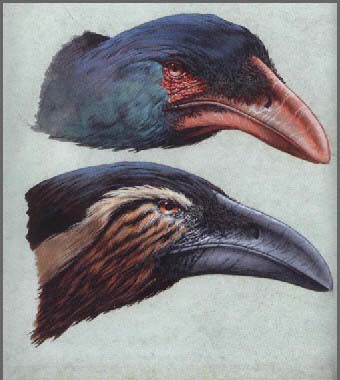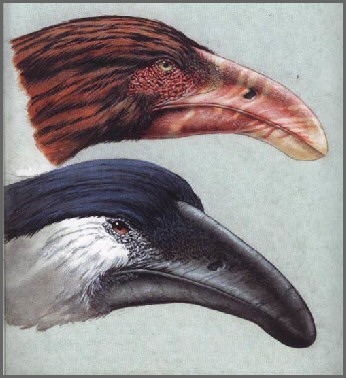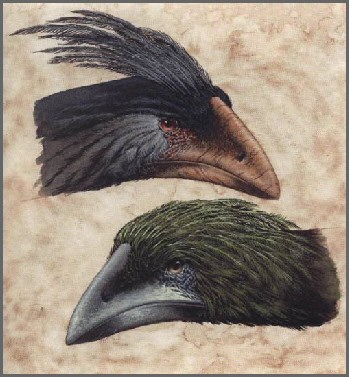
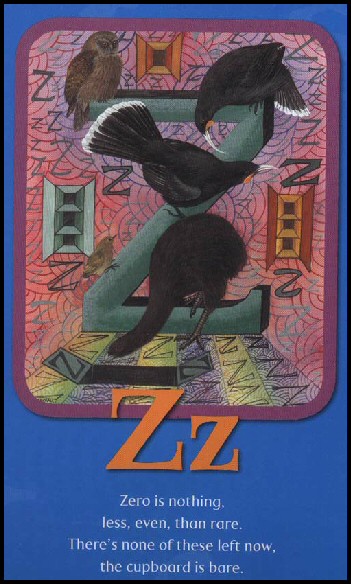 (from
K is for KIWI, Reed)
(from
K is for KIWI, Reed)
ON THIS PAGE YOU WILL FIND THE EXTINCT
BIRDS OF NEW ZEALAND:

LAUGHING OWL - HUIA - NZ THRUSH -
HAAST'S EAGLE - SOUTH ISLAND GOOSE -
NZ ADZEBILL - MOA
![]()
LAUGHING OWL / Whekau
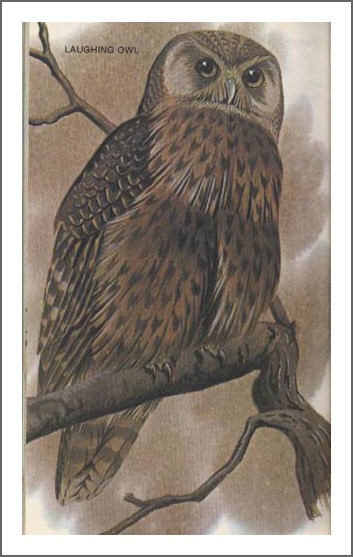
Laughing Owl Sceloglaux albifacies FAMILY: Strigidae Endemic and possibly extinct.
This is the largest of the NZ Owls being twice the size of the Morepork. They are dusky-brown
with greyish-white cheeks and pale 'socks'. Fully nocturnal. These owls were formally on the three
main islands of NZ, with the most plentiful reports coming from the eastern foothills of the Southern Alps.
However, there was a rapid decline in the 19th century. There have been no fully substantiated reports
since 1914 and the bird is now considered probably extinct. Unconfirmed reports are still being
received from throughout the South Island. Found in rocky areas at the margins of scrub and forest,
with a preference for limestone areas. They feed on small mammals, birds, insects, worms and lizards.
Breeding is from September to October and the nest is of dry grass, on bare ground, under boulders or
in fissures. The eggs, 1-3, are white.
![]()
HUIA
|
|
|
Huia Heteralocha acutirostris FAMILY: Callaeidae Endemic and probably extinct. Fully protected.
The size of a Magpie this bird is all black except for a white bill, large yellow wattles
and a conspicuous white tip to the tail. The female has the longer, slender curved bill.
Huia rarely fly, but bound rapidly along the ground or from tree to tree. They are usually
seen in pairs, feeding together. The male, with the shorter, straighter bill, finds the grubs
in rotten wood, then the female, with her long curved bill, probes the hole to extract the grub.
They were formally restricted to the North Island in Rimutaka, Tararua, Ruahine and Kaimanawa Ranges
and adjacent forests. There has been no authentic reports since 1907. Huia feed on grubs,
caterpillars, insects, spiders and fruits. Breeding is from October to November. The nest is large,
made of twigs and sticks in hollow trees or under cover close to the ground.
The eggs, 2-4, are stone-grey, with brown and purple spots and blotches.
![]()
NZ THRUSH / Piopio
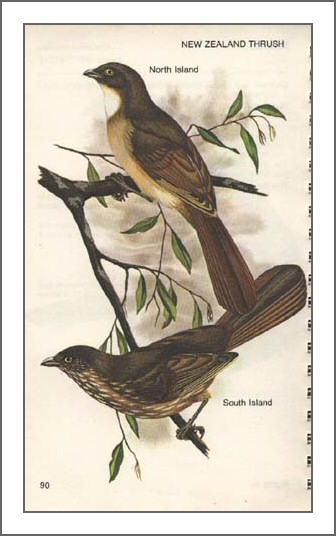
NZ Thrush Turnagra capensis FAMILY: Turnagridae Endemic, with two closely related sub-species,
both probably extinct. Fully protected. The size of a Tui, the North Island species being dusky-brown
on the back with a white throat and rusty-brown tail and rump. The South Island has brown
and white streaks below with a rusty-brown rump. They dart from tree to tree. Up to the 1880s
these birds were common in the forests of both islands, but they are now probably extinct.
There have been no authenticated reports since 1920 in the North Island and the 1940s in the South Island.
They feed on a varied diet of insects, fruits, seeds and vegetable matter, found mainly on the ground.
Breeding is in December and the nest is a compact structure of twigs and moss, lined with grasses
and fern scales, up to 4mt from the ground. The eggs, 2, are white, with black and brown spots
concentrated at the larger end.
![]()
HAAST'S EAGLE
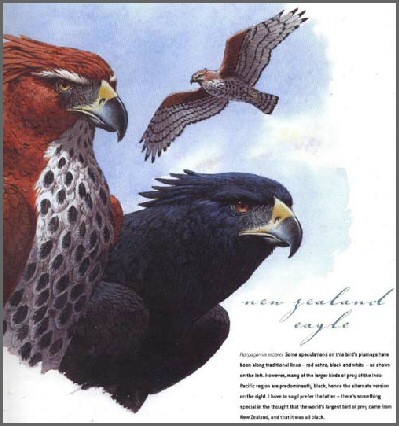 Image
copyright Dave Gunson
Image
copyright Dave Gunson
New Zealand Eagle Harpagornis moorei
Two possible plumages have been illustrated by Dave Gunson in the picture above.
This was the largest bird of prey in the world, with a wingspan of about 3 metres and talons
the size of a tigers.

SOUTH ISLAND GOOSE
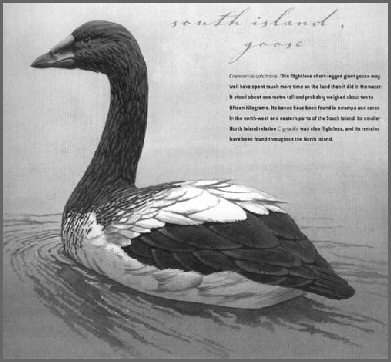 Image
copyright Dave Gunson
Image
copyright Dave Gunson
South Island Goose Cnemiornis calcitrans
This giant flightless, short-legged goose stood about 1mt tall and weighed up to 15kilgrams.
Bones have been found in swamps and caves in the Nth West and Eastern areas of the South Island.
There was a smaller North Island sub-species, Cnemiornis gracilis, which was also flightless,
and remains of this bird have been found throughout the North Island.

NEW ZEALAND ADZEBILL
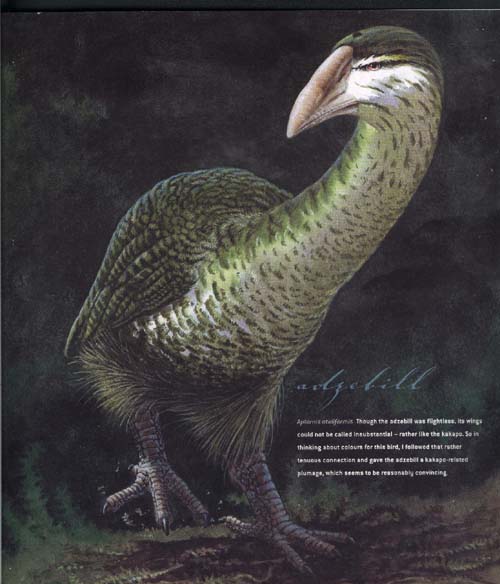 Image
copyright Dave Gunson
Image
copyright Dave Gunson
Adzebill Aptornis otidiformis
The flightless Adzebill had a massively strong skull and an imposing downward-curved bill.
Adzebills were about 80cms tall, probably weighing about 12 kilograms. This species seems to be unrelated
to any other NZ species but its diet was probably similar to other large flightless birds;
fruits, leaves, invertabrates and maybe lizards. Very few bones have been found of this bird.

MOA
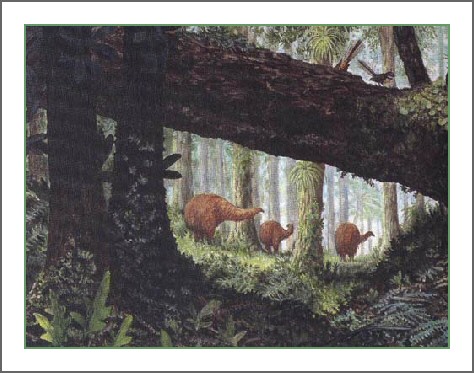 image
copyright Dave Gunson
image
copyright Dave Gunson
MOA HEADS
|
Alternative representations by Dave Gunson of the Large Bush Moa Dinornis novaezealandiae |
Alternative representation by Dave Gunson of the Giant Moa D. giganteus |
|
Two representations by Dave Gunson of the Crested Moa Pachyornis australis |
Moa were a unique species. The only known birds in the world to have no wing bones at all,
they ranged in size from turkey-sized to giant Moa measuring about 1.8 mts to the top of the back
and about 3 mts to the top of the head. The different species occupied a wide range of habitat,
including coastline, open country, forest and above the snowline. Moa had a shaggy, coarse plumage,
similar to the Kiwi and most had large powerful legs. Their food included fruit, leaves and branches,
and probably insects and lizards. They swallowed stones to assist in grinding vegetable matter
in the gizzard. Found in large numbers throughout NZ prior to human habitation, the Moa was hunted
for food by Maori, and along with introduced predators and desease which further desimated them,
were extinct by the time Europeans arrived. Moa eggs and bones continue to be found throughout NZ.

Other birds have become extinct in the last 200 years, including the Stephen's Island Wren and NZ Quail.












